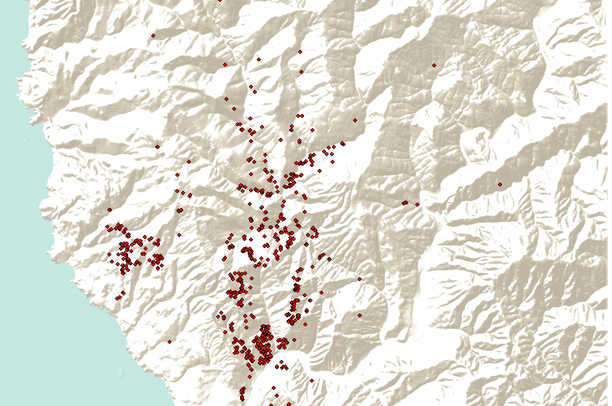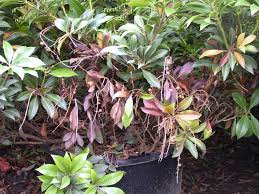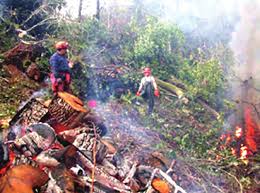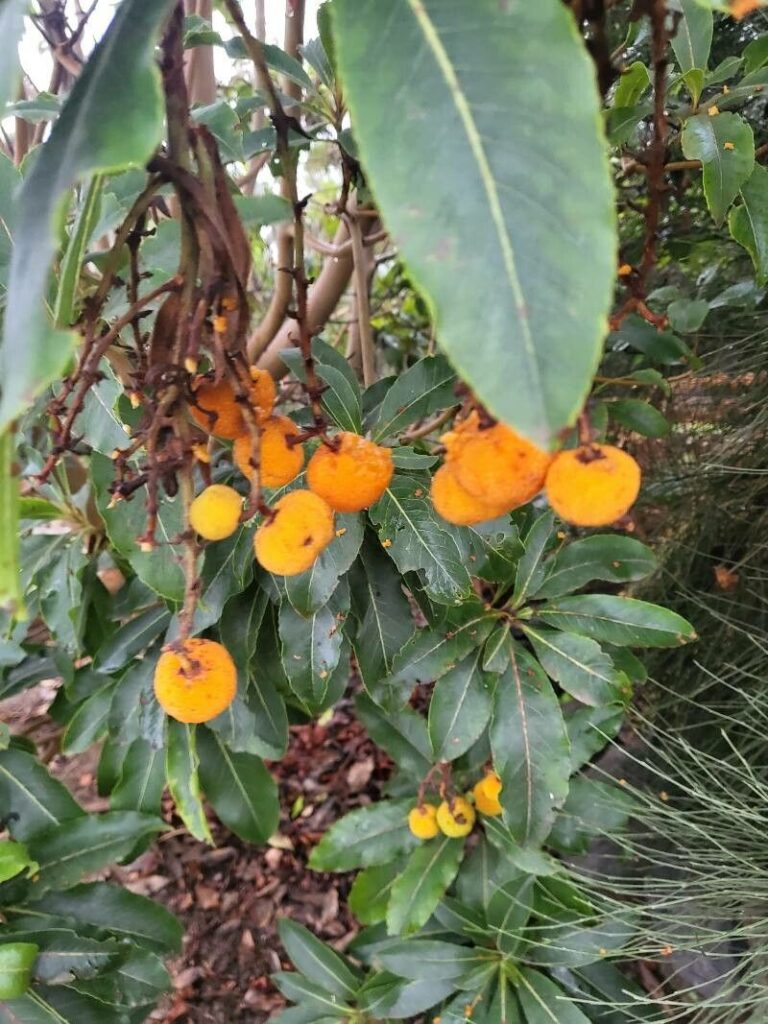In a recent blog I offered several critiques of APHIS’ new Phytophthora ramorum risk assessment regarding possible establishment of the causal agent of sudden oak death, in the eastern U.S. states. One of my objections was the brevity of its discussion of the likelihood of sexual combination of the recently introduced EU1 strain with the strain established in North America, NA1 and – more recently – NA2.
This blog provides updates on the status of the Phytophthora ramorum invasion in California and Oregon. My information comes primarily from the newsletter posted by the California Oak Mortality Task Force (COMTF), supplemented by presentations at the recent on-line meeting.
Research by several scientists, including Tyler Bourret, now with USDA Agricultural Research Service, [summarized in the November 2023 COMTF annual meeting] reported that 216 species are now recognized in the genus Phytophthora.
Establishment of Additional Strains of the Pathogen
Scientists now recognize 12 strains of P. ramorum (Sondreli et al., summarized in COMTF newsletter for August 2023). Three of these strains are established in western North American forests. All three – NA1, NA2, & EU1 – are established in southern Curry County, Oregon. Two of the three – EU1 & NA1– are established in neighboring Del Norte County, California. The genetic lineage of the EU1 population in Del Norte points to a link to the Oregon outbreak. [Robinson/Valachovic presentation to COMTF annual meeting November 2023] Given the poor record of efforts to prevent additional introductions of P. ramorum to the United States (the APHIS risk assessment notes that the pathogen has been introduced eight to14 times – or more! — in California), continued introductions of strains not yet established in the U.S. appear likely. Once a strain is established in a North American nursery, it is very likely to spread to nurseries – and possibly forests – in other parts of the country. Remember, the risk assessment reported that P. ramorum has probably been moved over a thousand times on nursery stock from West Coast nurseries across the U.S.
Why this matters
Phytophthora ramorum can reproduce sexually only when gametes of the two different mating types (A1 & A2) combine. Most of the North American populations are A2 mating type and most European populations are A1. Establishment of the European EU1 in Oregon and California increases the likelihood that sexual reproduction will occur, which in turn increases the probability that the pathogen will evolve. Sexual combination between NA2 (mating type A2) & EU1 (mating type A1) has occurred at least once – in a nursery in British Columbia. Authorities believe this hybrid has been eradicated. However, the possibility of such matings remains.
The most widespread strain in North America is NA1. It was first detected in the forests north of San Francisco in the middle 1990s; and in Oregon in 2001. Infestations of NA1 are now found from central Curry County, Oregon to Monterey County, California.
The EU1 lineage was first detected in Oregon in 2015. How did it get there since it was previously known only in Europe? The outbreak in Del Norte County, California – detected in 2020 – apparently is associated with the Oregon infection. [Robinson/Valachovic presentation to COMTF annual meeting November 2023] Both states attempted eradication, but the strain is well established. By 2023, the Oregon infestation was detected spreading at sites where intensive surveys in previous years detected no symptomatic trees. In California, new centers of infection have been detected along additional tributary creeks in the area. Scientists expect these infections to spread downhill. Control efforts and even surveys have been hampered by a large fire in the area, which diverted needed personnel and funding. [COMTF newsletter for October 2023 & Robinson/Valachovic]
The NA2 lineage has been found in some nurseries in the Pacific Northwest since 2005. The first detection in forests occurred near Port Orford, Oregon in 2021. Port Orford is 30 miles north of Gold Beach – the hitherto northern extent of the SOD infestation. Oregon authorities believed this signaled a new introduction to the state. By 2023, three sites in the state are now infested with this strain. [Ritokova presentation to COMTF annual meeting November 2023] Oregon now focuses its control efforts on NA2 outbreaks near Port Orford.
In California’s Del Norte County, there are now infestations of two strains of opposite mating types ~ 6 miles apart.The forests between them are conducive to infection, so interactions are likely. Robinson & Valahovic [COMTF annual meeting November 2023] ask how land managers should deal with any interactions. I ask – given the likelihood of hybrids forming – shouldn’t the APHIS risk assessment have tried harder to analyze this risk to the East?
Meanwhile, the NA1 strain continues to spread
In Oregon, the NA1 strain has spread 18 miles to the north and eight miles to the east since 2001 [Ritakova COMTF newsletter October 2023]. In California, spread after the wet winter of 2022-2023 has so far been less than expected. The SOD Blitz [Garbelotto at COMTF annual meeting November 2023] found that the statewide rate of positive trees rose from 7.1% in 2022 to 8.8% in 2023. In the Big Sur region some canyons now test negative that once were positive. Scientists think the negative tests reflect the multi-year drought. Scientists expect the spread will be more visible next year – especially if there is a second wet winter.
As noted above, the exception is in Del Norte County – an area described by CAL FIRE forester Chris Lee as a very wet “pathology” site. SOD (NA1 strain) was first detected in the area north of Crescent City in 2019 [Robinson and Valachovic]. This outbreak could not be re-confirmed for three years, despite intensive surveys. But, in 2022, scientists detected a new concentration of dying tanoak. The infected area is near both rare plants associated with serpentine soils and Jedediah Smith State Park, a unit of Redwood National Park. [Robinson] Meanwhile, the infestation of EU1 strain was first detected in 2020; it has expanded in 2022 and 2023.
In addition to spread facilitated by weather, we also see a continuing role in pathogen transfer via movement of shrubs intended for planting. In fall 2022 Oregon authorities were alerted by a homeowner to an outbreak in Lincoln City, Oregon. This was alarming for four reasons:
- it was 201 miles north of the generally infested area in southern in Curry County.
- it was well established and had apparently been present for many years.
- P. ramorum was not detected in any associated waterways, raising questions about the efficacy of this standard detection method for use in community detections.
- one of the infected plants was a new host: western sword fern (Polystichum munitum).
Fortunately, the infection has not (yet) been detected in nearby natural forests. Perhaps this is because there are no tanoaks this far north.
Detection Difficulties
Forest pathologists report several examples of outbreaks involving dozens of trees or plants suddenly being detected in areas which had been surveyed intensively in preceding years with no detections. See Robinson/Valachovic presentation [COMTF annual meeting November 2023, re: both EU1 & NA1 strains in Del Norte County]. I noted above that streams near the Lincoln City, Oregon neighborhood outbreak did not test positive. Nor did water associated with a positive nursery in Oregon[description of Oregon Department of Agriculture nursery regulatory program in COMTF newsletter for August 2023]. Stream baiting is an important component of detection surveys, so I worry about the possible implications of these negative results.
Identification of Additional Hosts [all from COMTF newsletter for August 2023.]
- silverleaf cotoneaster Cotoneaster pannosus (an invasive non-native plant species)
- “Mountain Moon” dogwood Cornus capitata [host previously identified in the United Kingdom]
- western swordfern (Polystichum munitum) (discussed above)
Management
Oregon has tried to manage SOD in the forest since its first detection, but the pathogen’s spread and the recent appearance of two additional strains have overwhelmed the program. One hope was to find a less expensive eradication or containment method. For 20 years, attempts to suppress the disease has focused on eradicating local populations of tanoaks (Notholithocarpus densiflorus) because they are the principal host supporting sporulation in Oregon. When an outbreak has been detected and delimited, they first kill the tanoaks with herbicides to prevent resprouting from the roots. The trees are then felled, piled, and burned. This treatment costs $3,000 – $5,000 / acre. Scientists tested whether they could greatly reduce the cost of the suppression programs by leaving tree boles standing after they have been killed by herbicide. Unfortunately, leaving dead, herbicide-killed trees standing increased sporulation, so this approach would probably exacerbate pathogen spread. [See Jared LeBoldus presentation to COMTF annual meeting November 2023]
Worrying Developments in Europe
In Ireland, sudden larch death – caused by the EU1 strain on Japanese larch (Larix kaempferi) – has spread to several counties. This strain is also causing disease on European beech (Fagus sylvatica) & Noble fir(Abies procera) in locations where these tree grow in association with nearby heavily infected Japanese larch. The EU2 lineage was found in late 2021, infecting L. kaempferi at one site.
Several other Phytophthora species are causing disease on trees, including P. lateralis on Lawson’s cypress, Port-Orford cedar (Chamaecyparis lawsoniana); P. pseudosyringae on Japanese larch; and P. austrocedri on trees in the Juniperus and Cupressus genera.
[information about Ireland from R. O’Hanlon, summarized in COMTF newsletter for August 2023]
Regulation
The European Union has relaxed phytosanitary regulation of Phytophthora ramorum. Previously the species – all strains – was considered a quarantine pest. Now its regulatory status depends on the origin of the infected material. “Non-EU isolates” of Phytopththora ramorum are still quarantine pests (presumably the two North American strains [NA1 & NA2] and the eight other strains identified in Asian forests). These pests are treated as the most serious pests in the Union; when they are detected, extensive control actions must be taken. “EU isolates” (presumably EU1 & EU2) are now treated as regulated non-quarantine pests. The focus is to limit the spread of these on plants for planting only.
The European Union and USDA APHIS regulatory emphases differ to some extent (APHIS does not regulate P. ramorum in natural settings, only interstate movement via, inter alia, the nursery trade). However, I am worried that both seem intent on minimizing their regulatory programs.
Another region at risk
Macaronesia is a group of several North Atlantic islands,e.g., Madeira and the Azores, Canary, and Cape Verde islands. The islands have climates similar to areas affected by P. ramorum. The Macaronesian laurel forest is a remnant subtropical evergreen forest which shares some plant taxa with those that host the pathogen elsewhere. Moralejo et al. found that, overall, plant species showed considerable tolerance of the pathogen. However, P. ramorum was “rather aggressive” on Viburnum tinus, Arbutus canariensis and Ilex canariensis. Furthermore, mean sporangia production on five Macaronesian laurel forest species was similar to levels on Umbellularia californica, a key host driving the SOD epidemics in California.Moralejo et al. concluded that there is a moderate to high risk of establishment if Phytophthora ramorum were introduced in the Macaronesian laurel forest. [Study summarized in October 2023 COMTF newsletter.]
Important Research
The COMTF August newsletter reports exciting work developing improved detection tools for Phytophthora species, especially P. ramorum. Sondreli, Tabima, & LeBoldus have developed a method to quickly distinguish among the four most common clonal lineages (NA1, NA2, EU1 and EU2). These assays are sensitive to weak concentrations and effective in testing a variety of sample types including plant tissue and cultures. Oregon State University is already using in its diagnostic laboratory.
YuFang, Xia, Dai, Liu, Shamoun, and Wu have developed a simple, rapid, sensitive detection system for the molecular identification of P. ramorum that does not require technical expertise or expensive ancillary equipment. It can be used in laboratory or using samples collected from the field.
Quiroga et al. found that thinning – with or without burning of the slash – significantly reduced stand density and increased average tree size without significantly decreasing total basal area. This effect persisted for five years after treatments – especially when supported by follow-up basal sprout removal. Preventative treatments also significantly increased dominance of tree species not susceptible to Phytophthora ramorum.
In a study summarized in the October 2023 COMTF newsletter, Bourret et al. reported results of nearly 20 years of leaf baiting in watersheds covering an 800-mile section of the Pacific Coast in northern and central California. They found 22 Phytophthora & Nothophytophthora species. Several – including P. ramorum — were abundant and widespread. Some isolates in northern California differ from those found elsewhere. Mitochondrial sequences revealed multiple hybridization events between P. lacustris and P. riparia.
Bourret et al. also found that P. pluvialis is probably native to Western North America. The strain invasive on conifers in New Zealand probably originated in California rather than Oregon or Washington.
Jared LeBoldus and colleagues are studying the ecological impact of tanoak mortality in Oregon forests. [Summarized in November 2023 COMTF newsletter.] They expect impacts at various trophic levels and functions. Preliminary findings regarding the plant community show increases in understory and herbacious species diversity; a shift away from tanoak to Douglas-fir; and increased coarse woody debris. These findings are similar to results from studies in central California by Dave Rizzo and colleagues at UC Davis. LeBoldus is now studying the microbiome of plant leaves; soil mycorrhizal diversity; invertebrates and pollinators (loss of the large annual flower crop of tanoaks presumably affects pollinators). They hope in the future to study small mammal communities (which they expect to be affected by the loss of acorns).
Jared LeBoldus and colleagues also reported early results of genomic studies exploring disease resistance in tanoaks. Various scientists started such studies in the past, but so far all efforts have petered out due to absence of sustained funding, support from agency management, and links to facilities with the necessary tree improvement/breeding resources. (See Richard Sneizko’s description of requirements for resistance breeding, here.) I hope this project proves more sustainable.
Posted by Faith Campbell
We welcome comments that supplement or correct factual information, suggest new approaches, or promote thoughtful consideration. We post comments that disagree with us — but not those we judge to be not civil or inflammatory.
For a detailed discussion of the policies and practices that have allowed these pests to enter and spread – and that do not promote effective restoration strategies – review the Fading Forests report at http://treeimprovement.utk.edu/FadingForests.htm
or



